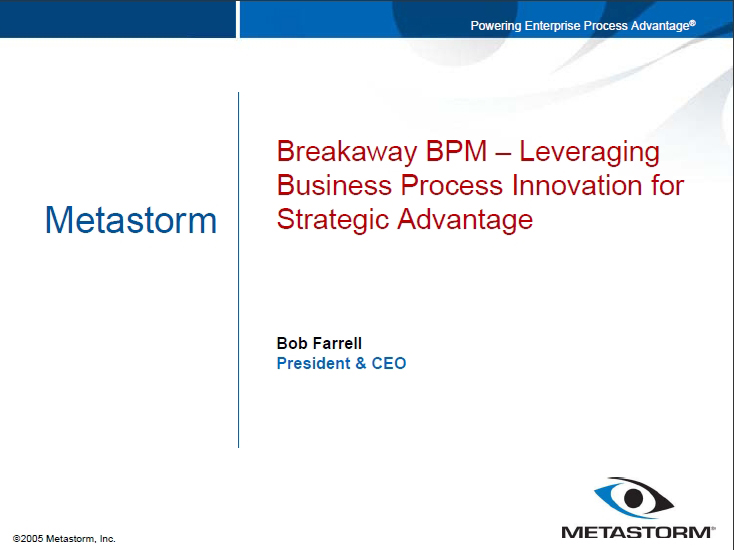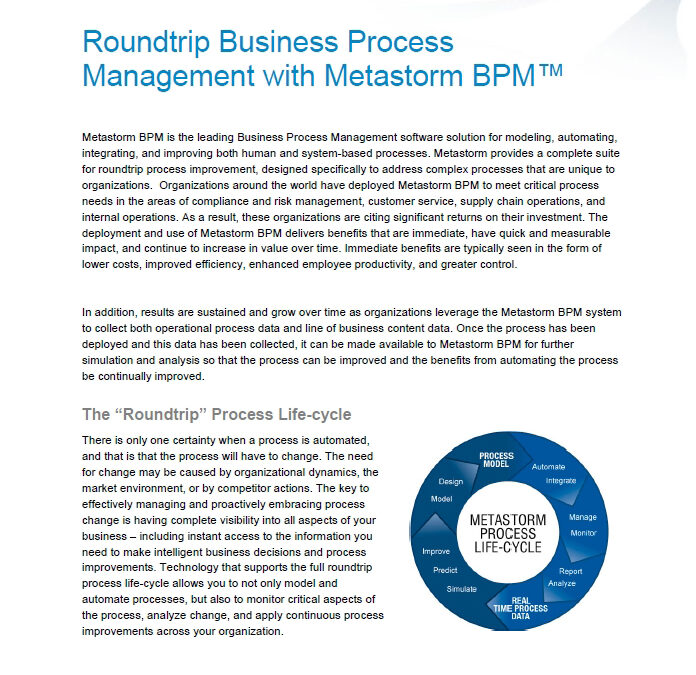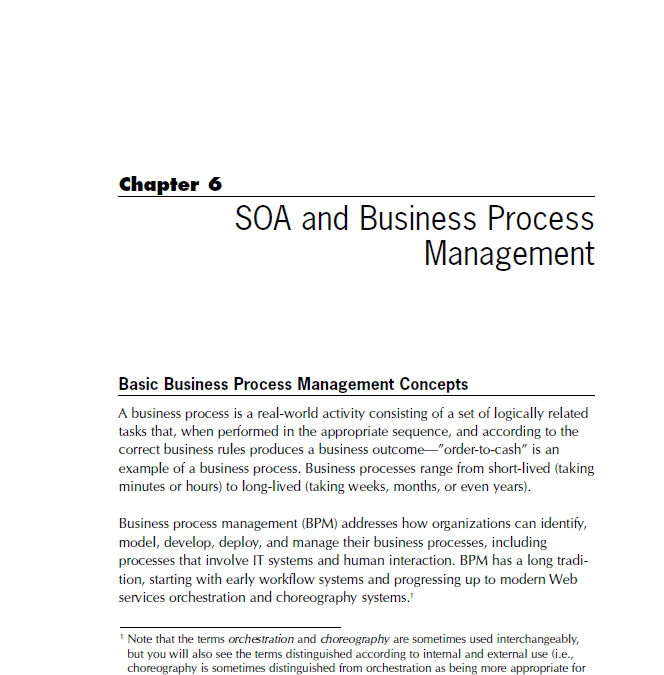Home / Resources
Resources
Discover a Wealth of BPM Knowledge and Expertise at BPMInstitute.org!

Proven Steps to BPM Success
As more and more vendors enter the market and try to stake a claim to the BPM opportunity, a few leaders have emerged to create a new era of business process management – an era defined by solutions that combine flexibility with a full spectrum of process capabilities. An era defined by vendors partnering with thought-leading business and government organizations to look at processes in terms of their ability to drive organizational growth. The era of “breakaway BPM”.
In this Webinar, David Holliday, CTO for Advanced Management Technology, Inc.
Planning for Improved Performance
Most any organization will surely concede that it desires improved performance. More precisely, most organizations expect their performance to improve. However, very few organizations actually plan to enhance their performance. They simply expect it to happen as a normal course of business.
Business Process Management – What Are Your Standards?
After speaking at a Six Sigma conference I was asked what my definition of BPM is and what differentiates it from Six Sigma. The topic of my presentation was how to identify important change programs. I am not sure what exact wording I used but I must have first stated that I am not a Six Sigma expert, only a Six Sigma customer, but Six Sigma did not seem to use standards. The BPM definition must have included process measurement, modeling and change planning. Later in my hotel room I realized I never put to paper what my definition is of BPM.
Who, What and How of a Business Analyst?
Who?
Business Analysts identify the business needs of their clients and stakeholders to help determine solutions to business problems. They typically perform a liaison function to software developers by serving as business problem solvers. They play a vital role throughout the project life cycle by understanding and representing stakeholder needs, documenting and organizing the requirements for a system, and communicating requirements to an entire team.
The Principles of Service-Orientation: Service Contracts and Loose Coupling
In the previous article we established the service-orientation design paradigm as currently providing us with the following eight common principles:
•services share a formal contract
•services are loosely coupled
•services abstract underlying logic
•services are reusable

Incorporating Existing Systems into SOA
You have dedicated significant resources to creating a services oriented architecture (SOA), investing heavily in hardware, software and personnel. You have trained people, hired experts, engaged vendors and deployed small scale services under an SOA framework. You have moved beyond the crawling stage and are ready to advance to the next stage of SOA deployment. But there is an elephant in the room no one wants to mention – your existing systems.
The Principles of Service-Orientation: Introduction to Service-Orientation
This is the first article in an eight-part series dedicated to exploring the common principles of service-orientation. Acclaimed author Thomas Erl shares his insights into the service-orientation design paradigm by providing excerpts from his second SOA book “Service-Oriented Architecture: Concepts, Technology, and Design”, supplemented with additional commentary.
The adoption of SOA often comes with an expectation that many of the benefits commonly associated with service-oriented technology platforms will be realized simply through their successful implementation.
Mining Rules from Code: Reasonable or Lunacy?
Is your organization challenged with the need to take an existing legacy system and re-architect it into new technology? But, what happens if that legacy application has no current system documentation, no available application SMEs or business SMEs who you can interview to identify how the existing system works?
The solution is the vision of Business Rules, with emphasis on business rule mining. Business rules are the most essential, non procedural statements behind business policy and requirements.

Facilitating Process Design
Tammy Adams is a certified process facilitator specializing in Team Facilitation and Business Process Analysis. She guides teams in transforming their process knowledge and business requirements into viable project and system deliverables that incorporate quality principles consistent with quality methodologies such as TQM, Six Sigma, and Lean. She is co-author of, “Facilitating the Project Lifecycle: Skills and Tools to Accelerate Progress for Project Managers, Facilitators, and Six Sigma Project Teams.”

Non-Technical Issues Matter Too
Too many organizations think they can implement business process management (BPM) efforts with nothing more than a comprehensive set of tools and a good ROI story.

BPMS Watch: BPM’s Evolving Value Proposition
I’ve been speaking at BPM conferences for – well, too long, probably – but long enough to see the evolution of BPM’s essential value proposition, as expounded by consultants, industry analysts, and BPMS vendors. Consistent with Darwinian theory, this evolution has not followed a simple linear thread but has branched into multiple lines, some destined to die out and others – hopefully – to flourish. Today I would say there are three distinct branches, three different statements of what BPM is and is trying to do. Each has its own natural constituency and ardent advocates.

BPM’s “Missing Link”
There’s something wrong with BPM, something terribly wrong. Although the past five years have witnessed great progress in the theory and practice of business process management, if we go back to business-process basics, a fundamental problem with BPM becomes clear.
Business Analysis and SOA: The Benefits of Business Services
This is the first article in a six-part series dedicated to exploring how SOA and service-orientation relate to and affect business analysis processes and approaches.

Roundtrip Business Process Management with Metastorm BPM
There is only one certainty when a process is automated, and that is that the process will have to change. The need for change may be caused by organizational dynamics, the market environment, or by competitor actions. The key to effectively managing and proactively embracing process change is having complete visibility into all aspects of your business – including instant access to the information you need to make intelligent business decisions and process improvements.

The Virtues of Incrementalism
Because business process management provides a strong capability for business change, organizational and people issues are huge challenges. Adopting new technology places extensive demands on employees and their managers.
Teetering on the BPM Strategy Edge
Bischoff is an international expert on optimizing and automating business processes across silos and the extended enterprise. She also is recognized for her work in Web services, brand strategies, strategic planning, integration, and IT/organization alignment.
According to Bischoff, most organizations are in the “tactical” mode when it comes to BPM. In other words, they are still in the discovery phase when it comes to Business Process Management. Moving from the tactical model to strategic mode is the key to enterprise success and necessary when implementing BPM.

How Do You Use Enterprise Business Architecture (EBA)?
In the article titled Understanding Enterprise Business Architecture, the basic concepts and purpose of the Enterprise Business Architecture (EBA) were discussed. This second article continues the discussion and provides an overview of how to use the EBA. Just remember, the EBA is a model built with rigor and discipline, the same that is applied in the fields of engineering and construction. It is a formal model representing the business as a manifestation the strategy.

Just Enough Process Management
It’s easy to get caught up in the frenzy of doing something just to do it. We’ve all seen it happen. Companies who implement full blown quality programs, like Six Sigma, often find themselves lost in a myriad of unfocused green belt projects, unnecessary processes and mountains of paperwork. They did not comprehend the trickle-down impact such an implementation would have on the organization. Does that mean the program is bad? Absolutely not. But its implementation was not tailored to the needs and objectives of the company.

Avoid Compliance Silos in Business and IT – Leveraging Business Process Management
After responding to the first round of compliance requirements, businesses are now faced with a new set of internal challenges. They have come to realize that their control objectives are not always in line with business objectives. In fact, a number of businesses are experiencing additional compliance costs as a result of disconnects within their own organization.
Corporate compliance, now more than ever, demands an enterprise approach. A new level of collaboration between IT and business lines is required.

SOA and Business Process Management
The convergence of BPM, SOA, Web services, and XML promises to significantly improve corporate agility, reduce time-to-market for new products and services, reduce costs, and improve operational efficiency of IT systems. Chapter 6 from “Understanding SOA with Web Services” explores each of these technologies in depth and describes the pros and cons of the implementation of each. The authors also do a compare and contrast between orchestration and business process management including an examination of where BPEL falls short for BPM solutions.
Exclusive members-only chapter from:













